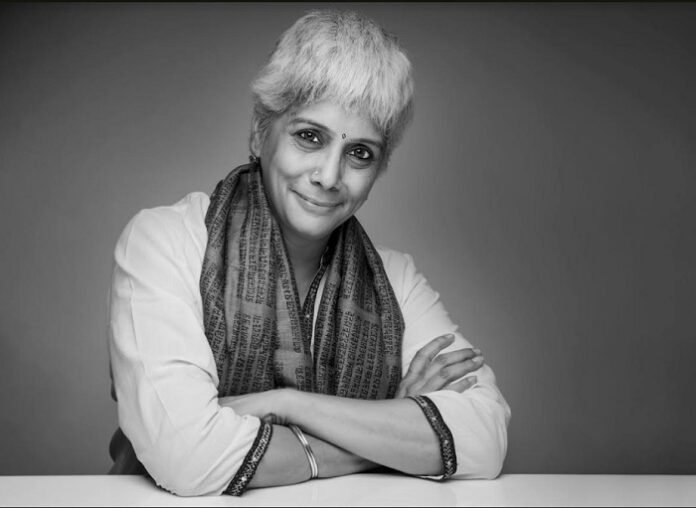
At the Children’s Kerala Literature Festival (CKLF) 2025 in January this year, correspondent Priyanka Tanwar had a conversation with Shobha Viswanath, co-founder and publishing director at Karadi Tales, about the crises in the Indian children’s publishing industry, specialized bookstores such as Kahani Tree for children, and multiculturalism, multilingualism, inclusiveness and diversity in the Indian children’s publishing today.
Edited excerpts:
Indian Printer & Publisher (IPP) – What was the idea and motivation behind starting Karadi Tales?
Shobha Viswanath – The word ‘Karadi’ actually means a bear in Tamil, Malayalam and Kannada. The name Karadi Tales refers to Karadi, the bear, who tells stories to his audience—all children. Karadi Tales turned 29 years old this year. We started the company because we wanted to publish audiobooks in India. Our first project under the publishing house was creating audiobooks. We started with folktales, retelling stories about our gods and goddesses. We got fabulous narrators such as Naseeruddin Shah, Saeed Jaffrey, Javed Jaffrey, Girish Karnad, and other names from the Indian theater scene to give voice to audiobooks from Karadi Tales. This was what started as an audiobook publishing house in 1996.
IPP – Please educate us about the crisis in the Indian children’s publishing industry.
Shobha Viswanath – Bookstores are closing down. Readers don’t want to visit bookshops. They want to buy online, and so the physical visibility of children’s books is diminishing across the country.
I am told, ‘aajkal bachche padhte nahi hain (these days, children don’t read). Children are not reading, that’s why books are not selling. I am saying no, children can’t see books because bookshops are shutting down. I think the bookshops’ closing is directly impacting the distribution system and putting a huge toll on publishers in terms of discounts and commissions.
IPP – There are specialized bookstores, such as Kahani Tree, for children. What are your views on specialty bookshops for children?
Shobha Viswanath – How many Kahani Trees are there in a country like India? One. How many Sangeetas are there? One. (Note: Sangeeta Bhansali is the owner of Kahani Tree, an independent children’s bookstore in Prabhadevi, Mumbai)
You need to have more Kahani Trees in every nook and corner. Only then will there be a renaissance or a resurrection of children’s books in India.
IPP – How do you focus on multiculturalism and multilingualism in your books?
Shobha Viswanath – India is a multicultural country. You cannot escape it. Our books cut across cultures. We have stories that are set all the way from Ladakh to Kanyakumari, the southernmost tip. We have stories set in Gujarat and in Bengal. We include our culture and diversity as much as possible.
We tend to publish only in English because that’s our strength. I would rather not get into areas that are not our expertise. I would love to publish a book in Bengali, but we don’t have people who are facile with the language within the publishing house, and, really, it’s not our domain.
IPP – Do you focus on inclusiveness and diversity? If yes, how?
Shobha Viswanath – We try to be as inclusive and as diverse as possible in what we publish. We have boys and girls in equal measure, who are the protagonists of our stories. Children who are differently abled. Children from different environments and cultures across demographics.
We have a story set in Ladakh called Thukpa for All (by Praba Ram and Sheela Preuitt with illustrations by Shilpa Ranade), which talks about a blind child. We have a child who wants to ride an elephant and be a mahout; primarily a male-dominated area. That story is set in Mysore (A Pair of Twins by Kavitha Mandana with illustrations by Nayantara Surendranath). We have a boy in Gujarat who wants to wear bangles (The Boy Who Wore Bangles by Riddhi Maniar Doda with illustrations by Shruti Hemani). We have incorporated foods from across the country.
IPP – Illustrations have a significant impact on children. Would you like to comment on the illustrations in your children’s books? How are illustrations made now different from those made in the past?
Shobha Viswanath – Well, clearly, the illustrations made now are far more digital than those in the past. Illustrations in the past were analog, which meant you took a piece of paper, you drew, you colored in it, you scanned it or photographed it, and sent it. Now, most illustrators use an iPad or a digital drawing board. Another major difference now is ‘control+Z,’ where you can correct your mistakes in a digital format.
I, personally, as publishing director of Karadi Tales, prefer hand-drawn, hand-colored illustrations. After the drawing is complete, you can, maybe, color-correct or make some adjustments on the computer. But I prefer they are hand-done traditionally. I find a certain warmth in it. Even if it does not turn out as perfectly as the digital medium, I like the imperfections in it.
IPP – What are the recent trends in children’s book publishing?
Shobha Viswanath – Well, we have broken away from telling the same old folktales and the same old stories from the epics and the Puranas. Even if those are told, they are told with a twist.
One trend I’m noticing is that people are focused largely on emerging issues – society as we see it today, society as the child experiences. Maybe there is a story about the mobile phone, which is invading everybody’s household, or a story about children being glued to the screen, or about dementia or Parkinson’s or about any other kind of disability, or about places that women go or girls go, which were primarily a male bastion.
IPP – There’s a common perception that picture books don’t sell well in India. What are your views?
Shobha Viswanath – What is well? Is 1 million copies well? Or 10,000 copies, or 100 copies? It’s subjective. But you are right to an extent that picture books don’t sell as much as maybe young adult literature. But I will also say the world and India are waking up to picture books. I know lots of people who are invested in buying picture books for their children.
IPP – The Indian children’s books publishing market is very fragmented. Your views.
Shobha Viswanath – It is fragmented because we have all kinds of books. I could produce a picture book, a really beautifully illustrated picture book with a wonderful story and gorgeous illustrations, a large format, hardback, beautiful paper. And I will price it, let’s say, at Rs 499. Then, there is another book that is dubious, but has glossy paper and is hardback. But the stories fall through, the illustrations are even worse, but it will be priced at Rs 150. The buyer sometimes has no discretion – they don’t see the difference between this and that. And so the fragmentation occurs.
There are activity and knowledge books. Some people buy books for their children so that they can get knowledge out of them and not simply for pleasure reading. But can I just read a book because I love it, because it’s funny and enjoyable? And not because I can take a moral away from it? The publishers serve all of these, and so you have so many fragments.
IPP – How do you see the future of children’s literature in India?
Shobha Viswanath – I’m hopeful. I think lots of parents are waking up to the idea of good books for children – whether they are picture books, chapter books or young adult books. There are lots of publishers in India who are very conscientious—working hard to bring out a good crop of literature that is contextual to our lives in the sense that they are not set in a Sweden or a Norway or the UK or anywhere. They are set in India. The characters in the story are ones the reader can relate to. So, I am very, very hopeful about the future of children’s literature in India.
The Children’s Kerala Literature Festival (CKLF), a specially curated platform for younger audiences, has been an exciting addition to the Kerala Literature Festival in recent years and continues to grow in scale and ambition. Tailored specifically for children and young adults, CKLF is designed to spark curiosity, creativity, and a lifelong love for reading and learning. Last year, CKLF collaborated with Karadi Tales, Pratham Books, Tulika Books, and others to bring celebrated authors and stories to readers across Kerala.
CKLF 2026 will be held alongside the Kerala Literature Festival from 22 to 25 January 2026 in Kozhikode (Calicut), Kerala. The curtain raiser for the ninth edition of the Kerala Literature Festival (KLF) will be held in December.
KLF is organized by the DC Kizhakemuri Foundation, a philanthropic organization formed as a tribute to the founder of DC Books, the late D C Kizhakemuri, a freedom fighter, social activist, writer, and publisher, and recipient of Padma Bhushan.
















